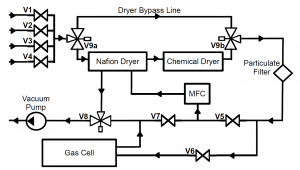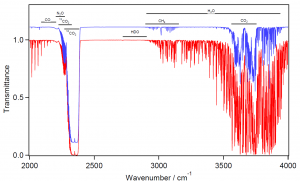Instrument Support Level 2
Ecotech Spectronus FTIR
Not applicable
Calendar

Ecotech Spectronus Fourier Transform Infrared Spectrometer (FTIR)
The Ecotech Spectronus is a state-of-the-art Fourier Transform Infrared Spectrometer (FTIR) that can simultaneously measure atmospheric concentrations of carbon dioxide (CO2), methane (CH4), nitrous oxide (N2O) and carbon monoxide (CO).
Currently this is the only commercially available instrument that can measure all of these trace gas concentrations in a single unit to the required precisions specified by the World Meteorological Organisations (WMO) Global Atmospheric watch (GAW). In addition, the Spectronus can determine the stable isotopic ratios in the measuredCO2 (denoted ?13C-CO2 and ?18O-CO2) by measuring and quantifying the three most abundant isotopologues separately. The instrument was installed at Weybourne in 2017 and support the UK’s contribution to the Integrated Carbon Observation Systems (ICOS) and the long-term observations within NCAS.
The Ecotech Sprectonus utilises an FTIR interferometer (IRcube, Bruker Optics, Germany) to modulate a broadband light source coupled to a 3.5 L multi-pass metal cell with 24m optical path length (schematic Figure 1).

The cell is continually flushed with dried ambient air, or calibration gases, and the transmission is measured across the broadband spectrum (1800 – 5000 cm-1) (Figure 2). Separate spectral regions are fitted on the spectrum for CH4 (3001 – 3150 cm-1), all isotopologues of CO2 (3520-3775 cm-1) and 13CO2, 12CO2, CO and N2O (2150-2320 cm-1).

The FTIR is routinely calibrated using calibration cylinders produced at the Integrated Carbon Observation Systems (ICOS) Flask and Calibration Laboratory. Five calibration cylinders, covering the ambient atmospheric range, are used to generate a response curve for CO2 (WMO X2007), N2O (WMO X2006A), CH4 (WMO X2004A) and CO (WMO X2014A).
The δ13C-CO2 and δ18O-CO2 are calibrated by accurately determining the mole fractions of the three most abundant isotopologues of CO2 (12C16O16O, 13C16O16O and 12C18O16O). An in depth description of how the δ13C-CO2 and δ18O-CO2 in the air sample can be determined using calibrations gases with known δ13C-CO2 and δ18O-CO2 values is described in detail in Griffith (2019).
Griffith, D. W. T. (2018). Calibration of isotopologue-specific optical trace gas analysers: A practical guide.
Data is displayed in near real-time on the Weybourne webpage
Archive Data
- Data is provided in NetCDF files following the AMOF data standard
- Instrument name is
- ncas-ftir-1
- The data product(s) associated with this instrument:
- Example data file
